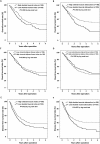Impact of preoperative body compositions on survival following resection of biliary tract cancer
- PMID: 31037838
- PMCID: PMC6711415
- DOI: 10.1002/jcsm.12431
Impact of preoperative body compositions on survival following resection of biliary tract cancer
Abstract
Background: Although surgical resection is the only potentially curative treatment for biliary tract cancer, the prognosis remains poor after a major operation such as pancreatoduodenectomy or hepatectomy. We aimed to investigate the impact of preoperative body compositions on long-term survival of patients undergoing resection of biliary tract cancer.
Methods: We analysed data of patients diagnosed with biliary tract cancer who underwent surgery from 2009 to 2015. Skeletal muscle area, skeletal muscle radiation attenuation, and visceral and subcutaneous adipose tissue areas were measured from the computed tomography images at L3 vertebral levels obtained before resection of cancer. Patients were divided into two groups based on the sex-specific median values for each parameter, and long-term survival was compared between the groups.
Results: A total of 371 patients (women, 39.6%; mean age, 66.2 ± 9.6 years) were finally included in the analysis. Patients with low skeletal muscle index (SMI) had significantly shorter median survival than those with high SMI (29 vs. 39 months; P = 0.026). Patients with low skeletal muscle attenuation (SMA) also showed reduced survival compared with those with high SMA (median survival 25 vs. 60 months; P = 0.002). Combining these two factors, survival was highest in the high SMI/high SMA group (reference) and lowest in the low SMI/low SMA group (hazard ratio, 2.18; 95% confidence interval, 1.44-3.30). Visceral and subcutaneous adipose tissue areas were not associated with long-term survival.
Conclusions: Low SMI and low SMA on computed tomography scan have a negative impact on survival after resection of biliary tract cancer. They can be used in preoperative risk assessment to assist in treatment decision making.
Keywords: Biliary tract cancer; Muscle attenuation; Sarcopenia; Survival.
© 2019 The Authors. Journal of Cachexia, Sarcopenia and Muscle published by John Wiley & Sons Ltd on behalf of the Society on Sarcopenia, Cachexia and Wasting Disorders.
Conflict of interest statement
The authors have no conflict of interests.
Figures


Similar articles
-
Impact of the preoperative quantity and quality of skeletal muscle on outcomes after resection of extrahepatic biliary malignancies.Surgery. 2016 Mar;159(3):821-33. doi: 10.1016/j.surg.2015.08.047. Epub 2015 Oct 23. Surgery. 2016. PMID: 26603849
-
Impact of body fat and muscle quantity on short- and long-term outcome after gastrectomy for cancer.Clin Nutr. 2022 Jul;41(7):1467-1474. doi: 10.1016/j.clnu.2022.05.002. Epub 2022 May 6. Clin Nutr. 2022. PMID: 35662018
-
Preoperative sarcopenia and post-operative accelerated muscle loss negatively impact survival after resection of pancreatic cancer.J Cachexia Sarcopenia Muscle. 2018 Apr;9(2):326-334. doi: 10.1002/jcsm.12274. Epub 2018 Feb 5. J Cachexia Sarcopenia Muscle. 2018. PMID: 29399990 Free PMC article.
-
Low skeletal muscle radiation attenuation and visceral adiposity are associated with overall survival and surgical site infections in patients with pancreatic cancer.J Cachexia Sarcopenia Muscle. 2017 Apr;8(2):317-326. doi: 10.1002/jcsm.12155. Epub 2016 Oct 26. J Cachexia Sarcopenia Muscle. 2017. PMID: 27897432 Free PMC article.
-
A systematic review of safety and efficacy of hepatopancreatoduodenectomy for biliary and gallbladder cancers.HPB (Oxford). 2016 Jan;18(1):1-6. doi: 10.1016/j.hpb.2015.07.008. Epub 2015 Nov 30. HPB (Oxford). 2016. PMID: 26776844 Free PMC article. Review.
Cited by
-
High Fat-to-Muscle Ratio Was Associated with Increased Clinical Severity in Patients with Abdominal Trauma.J Clin Med. 2023 Feb 14;12(4):1503. doi: 10.3390/jcm12041503. J Clin Med. 2023. PMID: 36836037 Free PMC article.
-
Skeletal muscle mass and quality before preoperative chemotherapy influence postoperative long-term outcomes in esophageal squamous cell carcinoma patients.World J Gastrointest Surg. 2023 Apr 27;15(4):621-633. doi: 10.4240/wjgs.v15.i4.621. World J Gastrointest Surg. 2023. PMID: 37206067 Free PMC article.
-
Impact of imaging-diagnosed sarcopenia on outcomes in patients with biliary tract cancer after surgical resection: a systematic review and meta-analysis.World J Surg Oncol. 2024 Sep 2;22(1):229. doi: 10.1186/s12957-024-03516-0. World J Surg Oncol. 2024. PMID: 39218917 Free PMC article. Review.
-
Prognostic Significance of Sarcopenia in Advanced Biliary Tract Cancer Patients.Front Oncol. 2020 Sep 2;10:1581. doi: 10.3389/fonc.2020.01581. eCollection 2020. Front Oncol. 2020. PMID: 32984018 Free PMC article.
-
Prevalence and predictive value of sarcopenia in surgically treated cholangiocarcinoma: a comprehensive review and meta-analysis.Front Oncol. 2024 Mar 19;14:1363843. doi: 10.3389/fonc.2024.1363843. eCollection 2024. Front Oncol. 2024. PMID: 38571501 Free PMC article.
References
-
- Siegel R, Ma J, Zou Z, Jemal A. Cancer statistics, 2014. CA Cancer J Clin 2014;64:9–29. - PubMed
-
- Aljiffry M, Abdulelah A, Walsh M, Peltekian K, Alwayn I, Molinari M. Evidence‐based approach to cholangiocarcinoma: a systematic review of the current literature. J Am Coll Surg 2009;208:134–147. - PubMed
-
- Farges O, Fuks D, Le Treut YP, Azoulay D, Laurent A, Bachellier P, et al. AJCC 7th edition of TNM staging accurately discriminates outcomes of patients with resectable intrahepatic cholangiocarcinoma: by the AFC‐IHCC‐2009 Study Group. Cancer 2011;117:2170–2177. - PubMed
Publication types
MeSH terms
LinkOut - more resources
Full Text Sources

